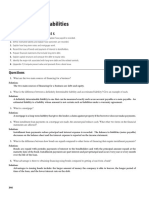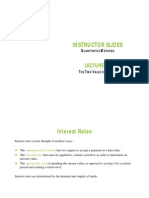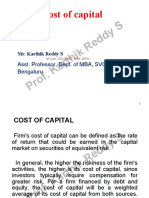12
12
Uploaded by
Ishaq EssaCopyright:
Available Formats
12
12
Uploaded by
Ishaq EssaCopyright
Available Formats
Share this document
Did you find this document useful?
Is this content inappropriate?
Copyright:
Available Formats
12
12
Uploaded by
Ishaq EssaCopyright:
Available Formats
Answers to End-of-Chapter Questions Chapter 12
1. Securities in the mortgage markets are collateralized by real estate. 2. Balloon loans require that a large final payment be made to pay off the remaining principal balance. Amortizing loans are structured so that equal monthly payments are made such that the total of all payments cover both interest and principal over the lifetime of the loan. 3. The global market for loans results in competition that keeps the rates low. 4. Discounts points paid when a loan is initiated result in a reduced interest rate. If the borrower plans to hold on to the loan long enough for the value of the reduced interest rate to exceed the up-front cost of the points, it is a good idea to elect to pay them. 5. A lien is a publicly recorded claim on a piece of real property that has been pledged as collateral. Mortgage lenders file liens to secure loans. 6. The down payment means that if the borrower chooses not make payments on the loan, the borrower will suffer some financial loss. This increases the likelihood that the borrower will continue to make the promised payments. 7. Lenders may require private mortgage insurance. 8. Most mortgage loans are sold to government agencies. These agencies establish criteria for which loans they will accept. If the loans do not meet these criteria, the initiating bank cannot sell them. 9. The Veterans Administration and the Federal Housing Administration guarantee lenders against losses from loans insured by them. Conventional loans do not have this guarantee, so the lender usually requires private mortgage insurance. 10. The loan is an adjustable-rate mortgage on which the interest rate is set at 2 percentage points above the prevailing Treasury bill rate. The interest rate can increase or decrease no more than 2% in one year and no more than 6% over its life. 12. The IRS allows the interest paid on first and second mortgage loans to be deducted from income before computing the amount of taxes due. This tax shield lowers the effective rate of interest on the mortgages. 13. The bank accepts the home as security and advances money each month. When the borrower dies, the borrowers estate sells the property to retire the debt. 14. A mortgage-backed security is one which has a pool of mortgages pledged as collateral. 15. The payments on a pool of mortgages are sent by the borrowers to a trustee, who then passes the payments through to holders of securities that are backed by the pass-through.
Quantitative Problems
1. Compute the required monthly payment on a $80,000 30-year, fixed-rate mortgage with a nominal interest rate of 5.80%. How much of the payment goes toward principal and interest during the first year?
64
Mishkin/Eakins Financial Markets and Institutions, Sixth Edition
Solution: The monthly mortgage payment is computed as: N = 360; I = 5.8/12; PV = 80,000; FV = 0 Compute PMT; PMT = $469.40 The amortization schedule is as follows: Beginning Balance $80,000.00 $79,917.26 $79,834.13 $79,750.59 $79,666.65 $79,582.30 $79,497.55 $79,412.38 $79,326.81 $79,240.82 $79,154.41 $79,067.59 Interest Paid $ 386.67 $ 386.27 $ 385.86 $ 385.46 $ 385.06 $ 384.65 $ 384.24 $ 383.83 $ 383.41 $ 383.00 $ 382.58 $ 382.16 $4,613.18 Principal Paid $ 82.74 $ 83.14 $ 83.54 $ 83.94 $ 84.35 $ 84.75 $ 85.16 $ 85.58 $ 85.99 $ 86.41 $ 86.82 $ 87.24 $1,019.65 Ending Balance $79,917.26 $79,834.13 $79,750.59 $79,666.65 $79,582.30 $79,497.55 $79,412.38 $79,326.81 $79,240.82 $79,154.41 $79,067.59 $78,980.35
Month 1 2 3 4 5 6 7 8 9 10 11 12 Total
Payment $ 469.40 $ 469.40 $ 469.40 $ 469.40 $ 469.40 $ 469.40 $ 469.40 $ 469.40 $ 469.40 $ 469.40 $ 469.40 $ 469.40 $5,632.83
Note that I highly recommend that you program the above calcs in Excel. It is pretty easy. You know the beginning balance, you can calculate the payment amount on your calculator or the =Payment function in Excel, it is easy to clac the interest due for each period as rate/12*balance at beginning of period. With all of that, you can calculate the principal paid in any period as payment interest paid. Of course, the ending balance for the period is then beginning balance principal paid in the period. I may ask you to calc the principal or interest paid in period 1 or 2 on the exam. 2. Compute the face value of a 30-year, fixed-rate mortgage with a monthly payment of $1,100, assuming a nominal interest rate of 9%. If this is the highest payment you can afford and dont have much to put down and the mortgage requires 5% down, what is maximum house price that you can afford? Solution: The PV of the payments is: N = 360; I = 9/12; PV = 1100; FV = 0 Compute PV; PV = 136,710 The maximum house price is 136,710/0.95 = $143,905
Chapter 12
The Mortgage Markets
65
3. Consider a 30-year, fixed-rate mortgage for $100,000 at a nominal rate of 9%. If the borrower wants to payoff the remaining balance on the mortgage after making the 12th payment, what is the remaining balance on the mortgage? Solution: The monthly mortgage payment is computed as: N = 360; I = 9/12; PV = 100,000; FV = 0 Compute PMT; PMT = $804.62 The amortization schedule is as follows: Beginning Balance $100,000.00 $ 99,945.38 $ 99,890.35 $ 99,834.91 $ 99,779.05 $ 99,722.77 $ 99,666.07 $ 99,608.95 $ 99,551.40 $ 99,493.41 $ 99,434.99 $ 99,376.13 Interest Paid $750.00 $749.59 $749.18 $748.76 $748.34 $747.92 $747.50 $747.07 $746.64 $746.20 $745.76 $745.32 Principal Paid $54.62 $55.03 $55.44 $55.86 $56.28 $56.70 $57.12 $57.55 $57.98 $58.42 $58.86 $59.30 Ending Balance $99,945.38 $99,890.35 $99,834.91 $99,779.05 $99,722.77 $99,666.07 $99,608.95 $99,551.40 $99,493.41 $99,434.99 $99,376.13 $99,316.84
Month 1 2 3 4 5 6 7 8 9 10 11 12
Payment $804.62 $804.62 $804.62 $804.62 $804.62 $804.62 $804.62 $804.62 $804.62 $804.62 $804.62 $804.62
Just after making the 12th payment, the borrower must pay $99,317 to payoff the loan. 4. Consider a 30-year, fixed-rate mortgage for $100,000 at a nominal rate of 9%. If the borrower pays an additional $100 with each payment, how fast will the mortgage payoff? Solution: The monthly mortgage payment is computed as: N = 360; I = 9/12; PV = 100,000; FV = 0 Compute PMT; PMT = $804.62 The borrower is sending in $904.62 each month. To determine when the loan will be retired: PMT = 904.62; I = 9/12; PV = 100,000; FV = 0 Compute N; N = 237, or after 19.75 years. 5. Consider a 30-year, fixed-rate mortgage for $100,000 at a nominal rate of 9%. A S&L issues this mortgage on April 1 and retains the mortgage in its portfolio. However, by April 2, mortgage rates have increased to a 9.5% nominal rate. By how much has the value of the mortgage fallen? Solution: The monthly mortgage payment is computed as: N = 360; I = 9/12; PV = 100,000; FV = 0 Compute PMT; PMT = $804.62 In a 9.5% market, the mortgage is worth: N = 360; I = 9.5/12; PMT = $804.62; FV = 0 Compute PV; PV = $95,691.10 The value of the mortgage has fallen by about $4,300, or 4.3%
66
Mishkin/Eakins Financial Markets and Institutions, Sixth Edition
7. Consider a 5-year balloon loan for $100,000. The bank requires a monthly payment equal to that of a 30-year fixed-rate loan with a nominal annual rate of 5.5%. How much will the borrower owe when the balloon payment is due? Solution: The required payment is computed as: N = 360; I = 5.5/12; PV = 100,000; FV = 0 Compute PMT; PMT = $567.79 The amortization schedule is as follows: Beginning Balance $100,000.00 $ 99,890.54 $ 99,780.58 $ 99,670.12 $ 99,559.15 $ 99,447.68 $ 99,335.69 $ $ $ $ $ 93,170.80 93,030.04 92,888.64 92,746.59 92,603.89 Interest Paid $458.33 $457.83 $457.33 $456.82 $456.31 $455.80 $455.29 $427.03 $426.39 $425.74 $425.09 $424.43 Principal Paid $109.46 $109.96 $110.46 $110.97 $111.48 $111.99 $112.50 $140.76 $141.40 $142.05 $142.70 $143.36 Ending Balance $99,890.54 $99,780.58 $99,670.12 $99,559.15 $99,447.68 $99,335.69 $99,223.19 $93,030.04 $92,888.64 $92,746.59 $92,603.89 $92,460.53
Month 1 2 3 4 5 6 7 56 57 58 59 60
Payment $567.79 $567.79 $567.79 $567.79 $567.79 $567.79 $567.79 $567.79 $567.79 $567.79 $567.79 $567.79
Just after making the 60th payment, the borrower must make a balloon payment of $92,461. 8. A 30-year, variable-rate mortgage offers a first-year teaser rate of 2%. After that, the rate starts at 4.5%, adjusted based on actual interest states. The maximum rate over the life of the loan is 10.5%, and the rate can increase by no more than 200 basis points a year. If the mortgage is for $250,000, what is the monthly payment during the first year? Second year? What is the maximum payment during the 4th year? What is the maximum payment ever? Solution: The required payment for the 1st year is computed as: N = 360; I = 2/12; PV = 250,000; FV = 0 Compute PMT; PMT = $924.05
Chapter 12
The Mortgage Markets
67
The required payment for the 2nd year is computed as: N = 348; I = 4.5/12; PV = $243,855.29; FV = 0 Compute PMT; PMT = $1,255.84 The maximum required payment for the 4th year is computed as: N = 324; I = 8.5/12; PV = $236,551.31; FV = 0 Compute PMT; PMT = $1,865.02 The maximum possible payment would occur in the 5th year if the 10.5% rate is required. The payment would be: N = 312; I = 10.5/12; PV = $234,187.24; FV = 0 Compute PMT; PMT = $2,193.93 10. Consider the following options available to a mortgage borrower: Loan Amount Option 1 Option 2 Option 3 $100,000 $150,000 $125,000 Type of Mortgage 30-yr fixed 30-yr fixed 30-yr fixed
Interest Rate 6.75% 6.25% 6.0%
Discount Point none 1 2
What is the effective annual rate for each option? Solution: Option 1: (1 + 0.0675/12)12 1 = 0.069628 Option 2: First, compute the effective monthly rate based on the points as follows: N = 360, I/Y = 6.25/12, PV = 150,000, compute PMT = 923.58 PMT = 923.58, N = 360, PV = 148,500, compute I/Y = 0.528789 Based on this, (1 + 0.00528789)12 1 = 0.065333 Option 3: First, compute the effective monthly rate based on the points as follows: N = 360, I/Y = 6/12, PV = 125,000, compute PMT = 749.44 PMT = 749.44, N = 360, PV = 122,500, compute I/Y = 0.515792 (1 + 0.00515792)12 1 = 0.063681
68
Mishkin/Eakins Financial Markets and Institutions, Sixth Edition
11. Two mortgage options are available: a 15-year fixed-rate loan at 6% with no discount points, and a 15-year fixed-rate loan at 5.75% with 1 discount point. Assuming you will not pay off the loan early, which alternative is best for you? Assume a $100,000 mortgage. Solution: Determine the effective annual rate for each alternative. 15-year fixed-rate loan at 6% with no discount points (1 + 0.06/12)12 1 = 0.061678 15-year fixed-rate loan at 5.75% with 1 discount point N = 180; I = 5.75/12; PV = $100,000; FV = 0 Compute PMT; PMT = $830.41 PMT = 830.41; N = 180; PV = 99,000; FV = 0 Compute I; I = 0.4921841 (1 + 0.004921841)12 1 = 0.060687 Based on these, you will pay a lower effective rate by paying points now. 13. Two mortgage options are available: a 30-year fixed-rate loan at 6% with no discount points, and a 30-year fixed-rate loan at 5.75% with points. If you are planning on living in the house for 12 years, what is the most you are willing to pay in points for the 5.75% mortgage? Assume a $100,000 mortgage. Note that the solution below is per the text. It is wrong. It is wrong because it only considers the payments for the first 12 years and ignores the balance at the end of 12 years. The balance on the 5.75% loan will be lower at the end of 12 years because a larger portion of the payments for the first 12 years get applied to principal pay-down. That is always true at a lower rate. The authors tried to make the problem fit a financial calculator easily. You should model a problem like this in Excel to properly solve it. In fact, this is a good problem for Solver. You could find the discount points level that makes the yield for the two alternatives equal. Solution : 30-year fixed-rate loan at 6% with no discount points This option has an effective monthly rate of 0.5%. I = 6.0/12; PV = $100,000; FV = 0; N = 360 Compute PMT; PMT = 599.55 Use this to back into points, as follows: I = 5.75/12; PV = $100,000; FV = 0; N = 360 Compute PMT; PMT = 583.57 The difference over 12 years is worth: N = 244; FV = 0; I = 6/12; PMT = 599.55 583.57 Compute PV; PV = 2,249.65 If the points on the 5.75% loan are less than 2.249, the 5.75% mortgage is a cheaper option over the life of the loan.
Chapter 12
The Mortgage Markets
69
14. A mortgage on a house worth $350,000 requires what down payment to avoid PMI insurance? Solution: $350,000 20% = $70,000. With this down payment, home owners are usually allowed to make their own property tax payments, instead of including it with their monthly mortgage payment. 18. Rusty Nail owns his house free and clear, and its worth $400,000. To finance his retirement, he acquires a reverse annuity mortgage (RAM) from his bank. The RAM provides a fixed monthly payment over 15 years on 70% of the value of his home at 5%. The payments are made at the beginning of the month. How much does Rusty get each month? Solution: This is a simple annuity due. The payments are: PV = 280,000; I = 5/12; N = 180; FV = 0; Calculator in BEGIN mode. Compute PMT; PMT = 2,205.03 Rusty will get $2,205.03 each month for 15 years. After that, he will owe $280,000. Typically, this forces the sale of the house, unless the contract specifies otherwise. 19. You are working with a pool of 1,000 mortgages. Each mortgage is for $100,000 and has a stated annual interest rate (nominal) of 6.00%. The mortgages are all 30-year fixed rate fully amortizing. Mortgage servicing fees are currently 0.25% annually. Complete the following table: (1) Beginning Balance 100,000,000 (2) Required Payment (3) Interest 500,000 (5) (6) Expected Servicing Principal Prepayment Fees 99,551 16,665 33,322 (4) (7) Ending Balance 99,750,430
Month 1 2
70
Mishkin/Eakins Financial Markets and Institutions, Sixth Edition
Solution: (1) (2) (3) (4) (5) (6) Beginning Required Expected Servicing Month Balance Payment Interest Principal Prepayment Fees 1 2 100,000,000 599,551 500,000 99,551 99,883,784 599,451 499,419 100,032 16,665 33,322 20,833 20,809 (7) Ending Balance 99,883,784 99,750,430
For month 1: The required payment is: PV = 100,000,000; I = 6/12; N = 360; FV = 0; Compute PMT; PMT = 599,551 Servicing Fees are: 0.0025/12 100,000,000 = 20,833 Ending Balance = 100,000,000 99,551 16,665 = 99,883,784 For month 2: The required payment is: PV = 99,883,784; I = 6/12; N = 359; FV = 0; Compute PMT; PMT = 599,451 Note this is valid with a pool of mortgages. The assumption is that complete mortgages are prepaying and leaving the pool. This will reduce the total monthly payment from the remaining mortgages in the pool. Servicing Fees are: 0.0025/12 99,883,784 = 20,809 Ending Balance = 99,883,784 100,032 33,322 = 99,750,430
You might also like
- Case Time Value of MoneyDocument7 pagesCase Time Value of MoneyHasibul Islam80% (5)
- 3 Year Projected Balance SheetDocument4 pages3 Year Projected Balance SheetJohn Cedrick0% (1)
- Chapter 14 HW SolutionDocument10 pagesChapter 14 HW SolutionIsmail Özdemir100% (1)
- Solution Chapter 4 - Time Value of Money and DCF Analysis - Finance BodieDocument20 pagesSolution Chapter 4 - Time Value of Money and DCF Analysis - Finance Bodielehoangthuchien100% (4)
- Project 1: Real Estate FinanceDocument18 pagesProject 1: Real Estate FinanceDilrajSingh100% (1)
- Corporate Finance Case StudyDocument13 pagesCorporate Finance Case StudySuduNo ratings yet
- Tut Lec 5 - Chap 80Document6 pagesTut Lec 5 - Chap 80Bella SeahNo ratings yet
- Options Trading For BeginnersDocument146 pagesOptions Trading For BeginnersMohaideen Subaire100% (8)
- Answers To Chapter 7 QuestionsDocument7 pagesAnswers To Chapter 7 QuestionsAnna OsmanNo ratings yet
- Finance Chpter 5 Time Value of MoneyDocument11 pagesFinance Chpter 5 Time Value of MoneyOmar Ahmed ElkhalilNo ratings yet
- Simple Interest PDFDocument3 pagesSimple Interest PDFDarwinNo ratings yet
- HW 2-SolnDocument9 pagesHW 2-SolnZhaohui ChenNo ratings yet
- Chapter6 Matematika BusinessDocument17 pagesChapter6 Matematika BusinessKarlina DewiNo ratings yet
- Amortization: ObjectivesDocument10 pagesAmortization: ObjectivesLara Lewis AchillesNo ratings yet
- TVM QsDocument9 pagesTVM QsEvince EarlNo ratings yet
- CH03Document5 pagesCH03Mohsin SadaqatNo ratings yet
- DerivativesDocument5 pagesDerivativesK.P.S DronesNo ratings yet
- TODAY at BULLET Chapter 2 TVM ContinuedDocument8 pagesTODAY at BULLET Chapter 2 TVM ContinuedSiêng Năng NèNo ratings yet
- TODAY at BULLET Chapter 2 TVM ContinuedDocument8 pagesTODAY at BULLET Chapter 2 TVM ContinuedThùy LêNo ratings yet
- Introduction To Personal Finance SEPT 2015 REVISION PACKDocument27 pagesIntroduction To Personal Finance SEPT 2015 REVISION PACKAnonymous p65I0YZVCNo ratings yet
- Accounting Chapter 10Document11 pagesAccounting Chapter 10Andrew ChouNo ratings yet
- Math 012 g5 Simple Annnuities 094300Document5 pagesMath 012 g5 Simple Annnuities 094300jbiventotabwNo ratings yet
- COMM 229 Notes Chapter 4Document4 pagesCOMM 229 Notes Chapter 4Cody ClinkardNo ratings yet
- GF520 Unit2 Assignment CorrectionsDocument7 pagesGF520 Unit2 Assignment CorrectionsPriscilla Morales86% (7)
- Chap 008Document5 pagesChap 008hasnat sakibNo ratings yet
- 7.-SLM Bus - Math Q1 W9Document11 pages7.-SLM Bus - Math Q1 W9Sir AronNo ratings yet
- MAPUA - EngEconLesson2 - Time Value of MoneyDocument39 pagesMAPUA - EngEconLesson2 - Time Value of MoneyRick SanchezNo ratings yet
- Accounting For Liabilities: Learning ObjectivesDocument39 pagesAccounting For Liabilities: Learning ObjectivesJune KooNo ratings yet
- Problems1 - Time Value of MoneyDocument6 pagesProblems1 - Time Value of MoneyEconomist Octavian OctaviusNo ratings yet
- Financial Management Ch06Document52 pagesFinancial Management Ch06Muhammad Afnan MuammarNo ratings yet
- Assignment1 SolutionDocument6 pagesAssignment1 SolutionAnonymous dpWU6H5Lx2No ratings yet
- Example Amortization ScheduleDocument3 pagesExample Amortization SchedulePankil R ShahNo ratings yet
- FIN303 Exam-Type Questions For Midterm 2Document10 pagesFIN303 Exam-Type Questions For Midterm 2bi2345No ratings yet
- General Mathematics LAS Q2 WK 6Document18 pagesGeneral Mathematics LAS Q2 WK 6Prince Joshua SumagitNo ratings yet
- Final Exam Review QuestionsDocument18 pagesFinal Exam Review QuestionsArchiePatelNo ratings yet
- Math 100 ProjectDocument10 pagesMath 100 Projectapi-566489640No ratings yet
- Answer FIN 401 Exam2 Fall15 V1Document7 pagesAnswer FIN 401 Exam2 Fall15 V1mahmudNo ratings yet
- Financial Accounting Module 11 - LiabilitiesDocument49 pagesFinancial Accounting Module 11 - LiabilitiesiksanrexitNo ratings yet
- Down Payments: Tighter Lending StandardsDocument10 pagesDown Payments: Tighter Lending StandardsraqibappNo ratings yet
- Chapter 006Document60 pagesChapter 006aisha belucciNo ratings yet
- Tutorial FIN221 Chapter 3 - Part 1 (Q&A)Document17 pagesTutorial FIN221 Chapter 3 - Part 1 (Q&A)jojojoNo ratings yet
- 03a 1Document5 pages03a 1ravi.gullapalliNo ratings yet
- 05 Lecture - The Time Value of Money PDFDocument26 pages05 Lecture - The Time Value of Money PDFjgutierrez_castro7724No ratings yet
- Consumer Mathematics: Borrowing: Loans and Loan RepaymentDocument22 pagesConsumer Mathematics: Borrowing: Loans and Loan RepaymentAlthea Noelfei QuisaganNo ratings yet
- Math Spring Final ProjectDocument4 pagesMath Spring Final Projectapi-355397592No ratings yet
- Soln 1Document5 pagesSoln 1rahulsbg01No ratings yet
- MalaDocument5 pagesMalaAruna MadasamyNo ratings yet
- CHAPTER 13 Debt Management in Retirement Planning PDFDocument35 pagesCHAPTER 13 Debt Management in Retirement Planning PDFMaisarah YaziddNo ratings yet
- ACG3141-Chap 14Document35 pagesACG3141-Chap 14Minh NguyễnNo ratings yet
- Module 3 Math1 Ge3Document10 pagesModule 3 Math1 Ge3orogrichchelynNo ratings yet
- MA170 Chapter 1Document8 pagesMA170 Chapter 1ishanissantaNo ratings yet
- Business Math Week 9Document10 pagesBusiness Math Week 9황혜진No ratings yet
- Chapter 7 Financial FunctionsDocument21 pagesChapter 7 Financial FunctionsNaushad AnwarNo ratings yet
- Week 9 Slides Rotman Fall 2021Document47 pagesWeek 9 Slides Rotman Fall 2021jasonmao6969No ratings yet
- Annuitie S: Liuren WuDocument39 pagesAnnuitie S: Liuren Wusaikumar selaNo ratings yet
- Itech Tutoring Comm 308 BookletDocument117 pagesItech Tutoring Comm 308 BookletAytekin AkolNo ratings yet
- STARTDocument5 pagesSTARTJust LearnNo ratings yet
- What The Banks Ask & Why: Everything You Need to Know before Applying for a Mortgage If You're Self-Employed or Have a Complex IncomeFrom EverandWhat The Banks Ask & Why: Everything You Need to Know before Applying for a Mortgage If You're Self-Employed or Have a Complex IncomeNo ratings yet
- Napkin Finance: Build Your Wealth in 30 Seconds or LessFrom EverandNapkin Finance: Build Your Wealth in 30 Seconds or LessRating: 3 out of 5 stars3/5 (3)
- BondPrices 04 Feb 2016Document2 pagesBondPrices 04 Feb 2016PuneetPurshotamNo ratings yet
- Gadgil FormulaDocument6 pagesGadgil FormulaHemant ShivakumarNo ratings yet
- Collection Result Update FY 2080 81 Upto 2081 02.01 1Document1 pageCollection Result Update FY 2080 81 Upto 2081 02.01 1Sunit BhattNo ratings yet
- HDFC Bank Project On CRMDocument70 pagesHDFC Bank Project On CRMfurqAnNo ratings yet
- The Indian Employee PF Black BoxDocument9 pagesThe Indian Employee PF Black BoxdhanasekarenNo ratings yet
- RM Assignment 1Document11 pagesRM Assignment 1Azura AyuNo ratings yet
- Budgeting: Faculty of Nursing Zagazig University Master Degree Second TermDocument11 pagesBudgeting: Faculty of Nursing Zagazig University Master Degree Second Termheba abd elazizNo ratings yet
- Kontabiliteti I Obligacioneve (Anglisht)Document11 pagesKontabiliteti I Obligacioneve (Anglisht)Vilma HoxhaNo ratings yet
- Scientific Macroeconomics & The Quantity Theory of CreditDocument67 pagesScientific Macroeconomics & The Quantity Theory of CreditRonitSingNo ratings yet
- Business Proposal: Shrimp Farm ProjectDocument38 pagesBusiness Proposal: Shrimp Farm Projectagus triyanto100% (1)
- ZsdeDocument1 pageZsdeAshish GuptaNo ratings yet
- Sample: Application Form Appointment of Distributors Information About YouDocument4 pagesSample: Application Form Appointment of Distributors Information About YouVenkateshNo ratings yet
- Unit 3 Cost of CapitalDocument41 pagesUnit 3 Cost of CapitalVïñü MNNo ratings yet
- Firms in Competitive MarketsDocument60 pagesFirms in Competitive Marketssaif09876No ratings yet
- Department of Education: Post-Aptitude TestDocument2 pagesDepartment of Education: Post-Aptitude TestMj Ong Pierson GarboNo ratings yet
- "Value Chain Configuration For Tesla Motors in Brazil": Antonio AddarioDocument18 pages"Value Chain Configuration For Tesla Motors in Brazil": Antonio AddarioArtforall CorpNo ratings yet
- Maritime Management: Dual Bachelor S Study ProgrammeDocument11 pagesMaritime Management: Dual Bachelor S Study ProgrammeRahul SunilNo ratings yet
- Wholesale Debt Market IndiaDocument9 pagesWholesale Debt Market IndiatawahidNo ratings yet
- Agreement FranchiseDocument9 pagesAgreement FranchiseRickEspinaNo ratings yet
- Employees Compensation ProgramDocument30 pagesEmployees Compensation ProgramEunnice M. MagculangNo ratings yet
- Business Plan Hair SalonDocument52 pagesBusiness Plan Hair SalonFazira Diana83% (6)
- Entrepreneurship: Quarter 2 - Module 9Document22 pagesEntrepreneurship: Quarter 2 - Module 9Rutchel89% (9)
- Stanford Executive Program: Sample Course DescriptionsDocument6 pagesStanford Executive Program: Sample Course DescriptionsAndy MengNo ratings yet
- Act101 Comprehensive ProblemDocument11 pagesAct101 Comprehensive ProblemAMNEERA SHANIA LALANTONo ratings yet
- Robert J. Barro - Getting It RightDocument207 pagesRobert J. Barro - Getting It RightRoger Mario LopezNo ratings yet
- Signing Date: 19/10/2023 03:18:09 SGT Signed By: Ds CWT India PVT LTD 2Document3 pagesSigning Date: 19/10/2023 03:18:09 SGT Signed By: Ds CWT India PVT LTD 2Himanshu MishraNo ratings yet
- Engineering Economy: (7th Edition)Document2 pagesEngineering Economy: (7th Edition)Joyce HerreraNo ratings yet
- Chapter 22 - Futures MarketsDocument9 pagesChapter 22 - Futures MarketsminibodNo ratings yet

























































































